Converged VDI Fundamentals
Wikibon research has shown that delivering software-led infrastructure as a converged appliance significantly reduces IT costs. The fewer the independent elements in the appliance stack, the lower the costs and the faster the time-to-value. If all the elements in a converged application stack are procured from a lesser number of vendors (ideally one), it also reduces the cost of deployment and the time-to-value of software implementations and upgrades.
Wikibon has also shown that delivering a converged application appliance has the potential to reduce the number of elements, increase savings, and decrease time-to-value even further. Appliances such as the Pivot3 VDI Appliance minimize the number of Managed Entities to reduce the set-up and operational costs, and duplicate public cloud deployment economics. The ideal appliance is a Single Managed Entity (SME). The Wikibon definition of SME includes:
- An integrated delivery of the solution as a single component;
- Regular singular, globally pretested updates to the solution;
- A single business partner for sales, deployment, maintenance and upgrades;
- A single hand to shake;
- A single throat to choke.
Pivot3
Pivot3 is a major contributor to the migration of video surveillance from the analog to the digital world. Wikibon expects surveillance data to be over 40% of the data volume from the Internet of Things, and has researched the importance of “Edge” devices in “The Vital Role of Edge Computing in the Internet of Things“. Pivot3 has developed a very efficient platform to meet the demanding low-cost requirement of Edge devices, combining virtualization, compute and storage services. Wikibon believes Pivot3 is well positioned to provide Edge devices for the IoT, and well positioned for converged appliances for other edge applications such as VDI.
Pivot3 has developed its vSTAC operating system using its own implementation of erasure coding, bypassing the hypervisor for storage processing. The OS optimizes processors for both storage and application processing. As a result, Wikibon rates Pivot3 as a highly efficient Server SAN, and a leading low-cost provider.
Pivot3 has created a single SME VDI converged application appliance for VMware’s Horizon View solutions. Pivot3 significantly reduces the cost of the storage and cluster management. Each node can be added into the rack, and the cluster recognizes additional nodes automatically and enables the resources to be utilized for additional VDI desktops with no operational intervention. This significantly reduces the complexity and risk of development, deployment, and support of the total stack software. In addition, it reduces the time to install new deployments and upgrades compared with the traditional “best-of-breed” white-box approach. Solutions built on top of converged application appliances require fewer integration points and reduce the number of unique problems that complicate support for vendors and users. Pivot3 has put in place the support and extensive testing of the solutions, acts as the single hand to shake, and is responsible for the whole stack.
Wikibon Research On VDI Converged Application Appliance
The fundamental concept put forward in previous research is that a single managed entity decreases the user’s cost of deployment, operations and maintenance. It also decreases the vendor’s costs for maintenance and deployment. The stack that we used in previous converged application research was application, database, middleware, OS, hypervisor, and hardware. In this research this is extended to VDI solutions, in particular with the VMware environment hypervisor. Pivot3 technology is at the bottom of the stack, providing the hardware and storage management. VMware vSphere provides the virtualization layer and virtualization cluster management layer. The VDI broker runs in virtual machines under the VMware hypervisor. The Pivot3 also provides the clustering technology that allows additional nodes to be added with almost no additional project cost. Pivot3 takes responsibility for the whole stack as a single deployment SME, providing a single update, maintenance & problem resolution service. Some additional aspects (such as tying into Microsoft Active Directory) are needed for total integration into the site. So the net SME value is a little over the perfect score of 1.0.
Within the research we looked at two deployment scenarios:
- One-time Deployment of 400 virtual desktops over three years (no increase in desktops);
- Deployment of the same 400 virtual desktops, increased by an additional 120 desktops at the beginning of years two and three.
The research analyzed the two scenarios deployed in two different ways
- A Traditional White-box Implementation Approach
- 400 VDI desktops are deployed on 6 Servers, 2.4TB Flash, and 12 TB Disk. Additional 2 servers with a proportional amount of flash and disk are deployed for each additional 120 desktops
- VMware’s vSphere & vCenter are deployed for the virtualization layer
- The VMware VSAN file system is used to manage the storage
- See Table 5 in the Footnotes for all the detailed assumptions
- A Pivot3 vSTAC VDI Appliance Implementation Approach
- 400 VDI desktops are deployed on 3 Appliances, with altogether 6 Servers, 300GB Flash, and 12 TB Disk. An additional appliance was deployed for each additional 120 VDI desktops
- VMware’s vSphere is deployed for the virtualization layer is deployed as part of the Pivot3 Appliance
- The Pivot3 storage management system is part of the Pivot3 software layer (including dynamic expansion of storage, network and processors, and no single point of failure.
- See Table 6 in the Footnotes for all the detailed assumptions.
The most important differences between the two approaches are the full integration of everything within each Pivot3 Appliance node, and the ability to cluster the original appliances and additional nodes automatically and seamlessly using a Gigabit Ethernet network. The only important advantage of the White-box approach is the initial lower hardware cost.
Figure 1 is a summary graph of the elapsed time and cost of the first deployment scenario (400 VDI desktops over three years). The columns on the left represent the traditional white-box approach. The columns on the right represent the Pivot3 appliance (single SME) approach. The origin of this data and the assumptions are taken from detailed Tables 1 & 2 in the footnotes below. The conclusion from Figure 1 is that using an Application Converged Appliance reduces the time-to-value from 21 days to just five (5) days, and the Pivot3 appliance reduces the three-year costs from $375,000 to $244,000, a savings of $131,000 dollars. The detailed assumptions are given in Tables 5 & 6 in the footnotes below and are an un-discounted cash-flow view without any depreciation. Table 3 in the footnotes extracts an IT budget view for the 400 VDI scenario from Tables 5 & 6, taking into account the depreciation on CAPEX items.
Looking at the cost/workstation/month, the cost is $17 for the Pivot3 appliance. The cost is $26 for a traditional white-box solution, 54% higher that the Pivot3 appliance.
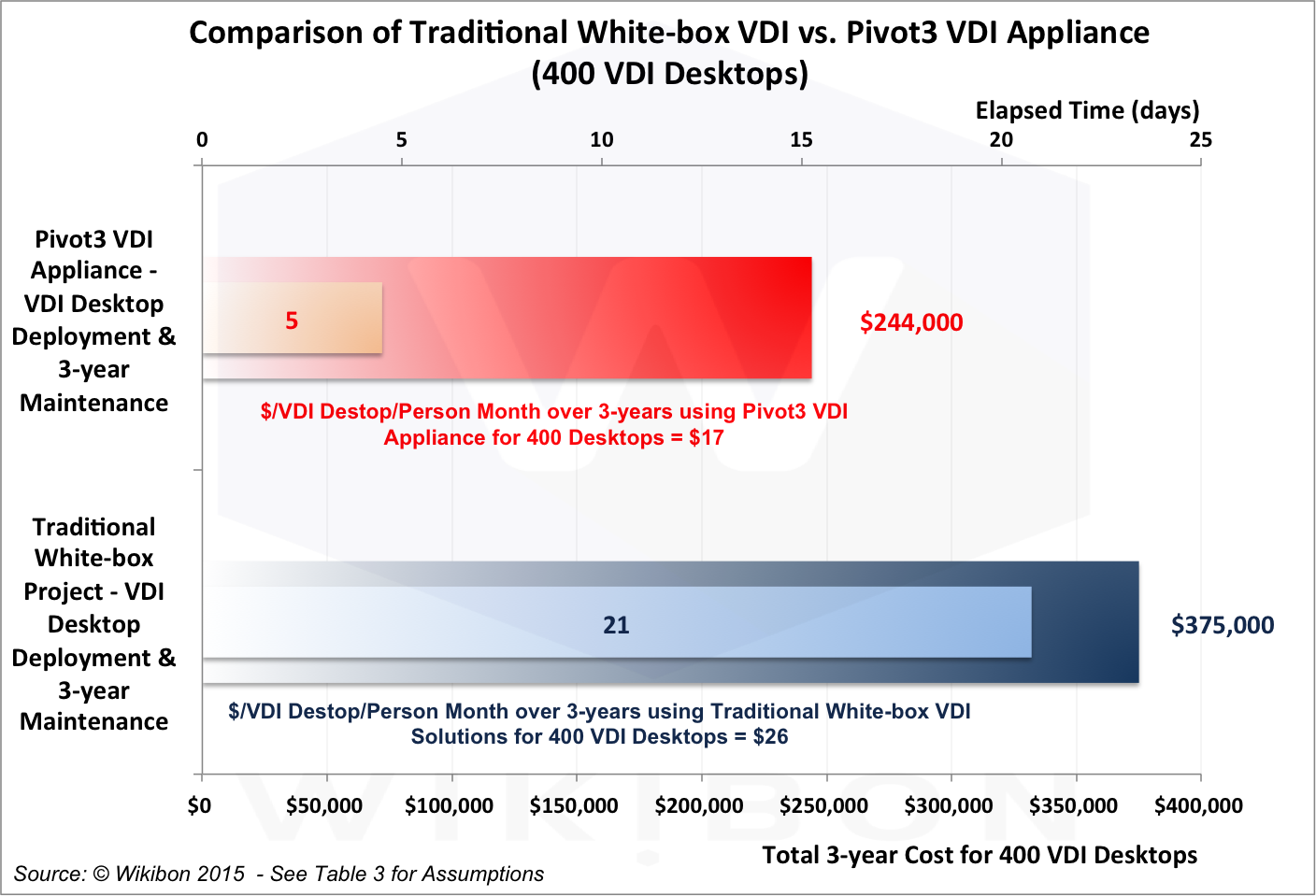
Source: © Wikibon 2015, based on the assumptions and calculations in Table 3 in the Footnotes, itself derived from Tables 5 & 6 in the Footnotes below.
Figures 2 just below shows a more detail breakout of the 400 VDI deployment scenario costs. The three-year hardware costs when deploying an appliance are about the $15,000 lower than a traditional white box, but the licensing cost is about $31,000 lower over three years. The savings in setting up is $22,000 less expensive using the Pivot3 solution. The operational costs of maintaining the Pivot3 environment is $63,000 lower than the traditional white-box approach.
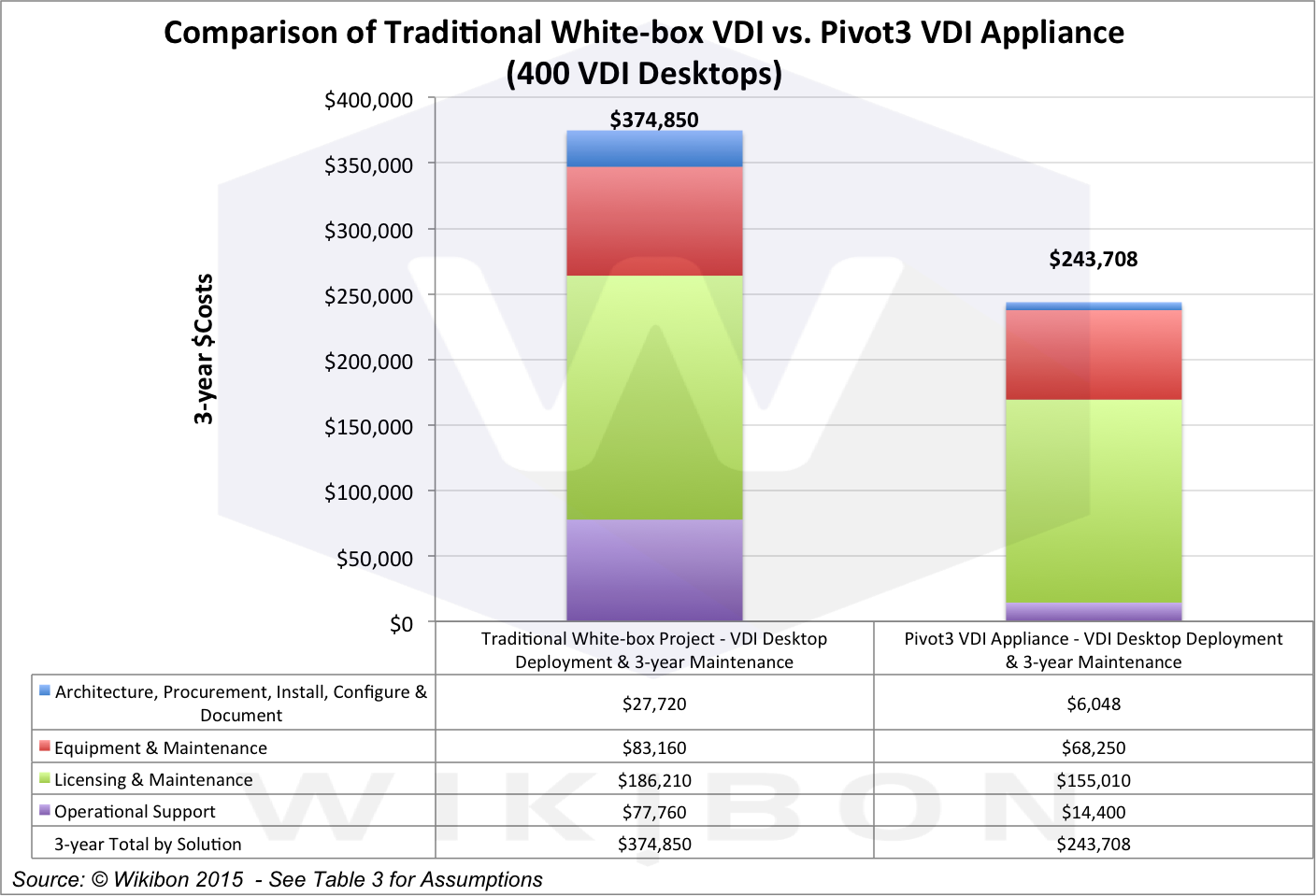
Source: © Wikibon 2015, based on the assumptions and calculations in Table 4 in the Footnotes, itself derived from Tables 5 & 6 in the Footnotes below.
Figure 3 below shows that elapsed time for each stage of a project is reduced by a factor of about four, from 21 days to five days.
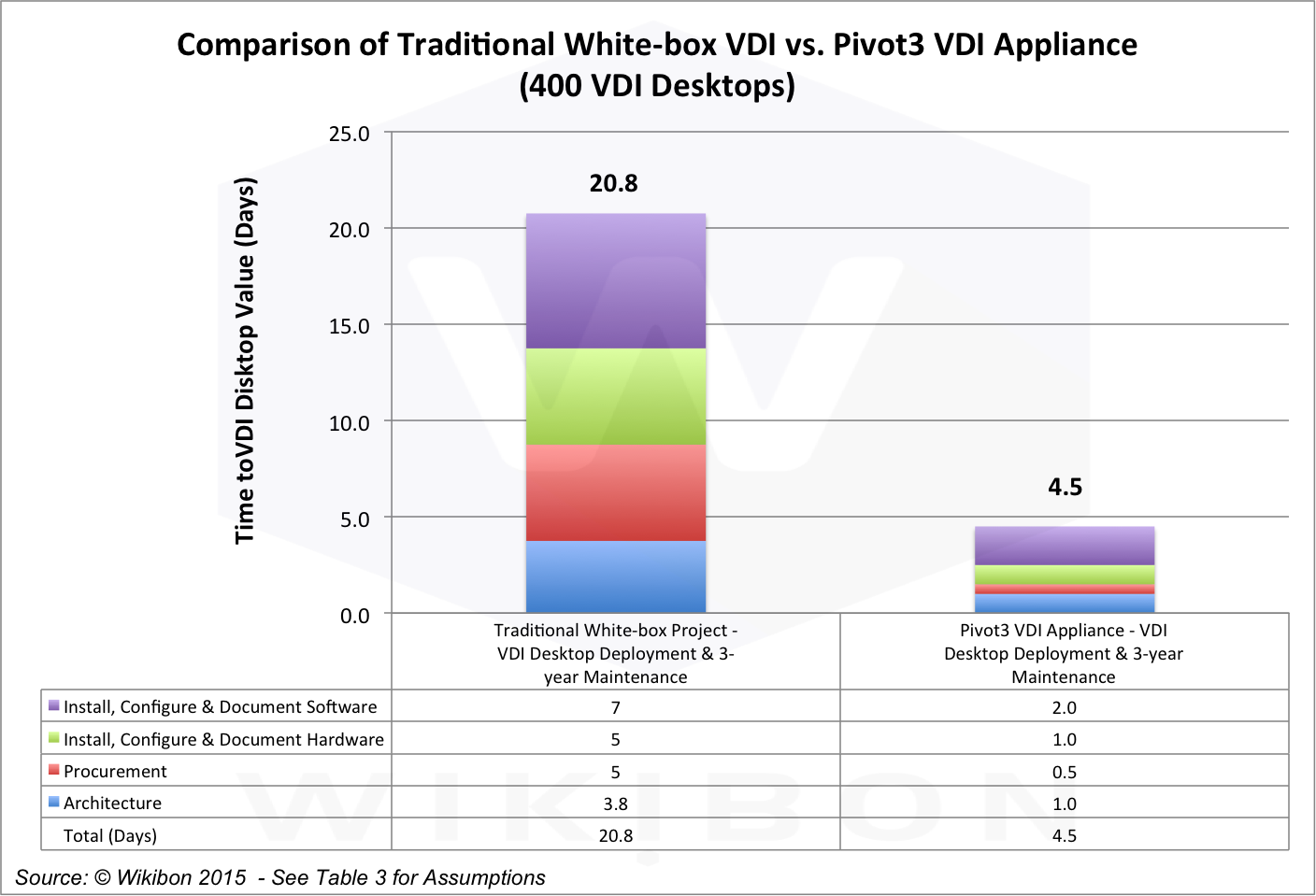
Source: © Wikibon 2015, based on the assumptions and calculations in Table 3 in the Footnotes, itself derived from Tables 5 & 6 in the Footnotes below.
Figure 4 is a summary graph of the elapsed time and cost of the second 640 VDI deployment scenario, assuming the same initial 400 VDI desktops and increasing them by 120 per year for a total of 640 desktops. The columns on the left represent using a traditional white-box approach. The columns on the right represent the Pivot3 application appliance (single SME) approach. The origin of this data and the assumptions are taken from Table 4 in the footnotes. The conclusions from Figure 4 is that using Application Converged Appliances reduces the time to value from 37 days to just six days, and the Pivot3 appliance reduces the three-year costs from $490,000 to $289,000, a reduction of about $201,000 dollars.
Looking at the cost/workstation/month, the cost goes down from $17 for 400 users to $15 for 640 users for the Pivot3 appliance, because it is much simpler to extend the cluster from 2 nodes to 3 nodes. The cost remains at $26 for a traditional white-box solution, which is 70% higher that the Pivot3 appliance.
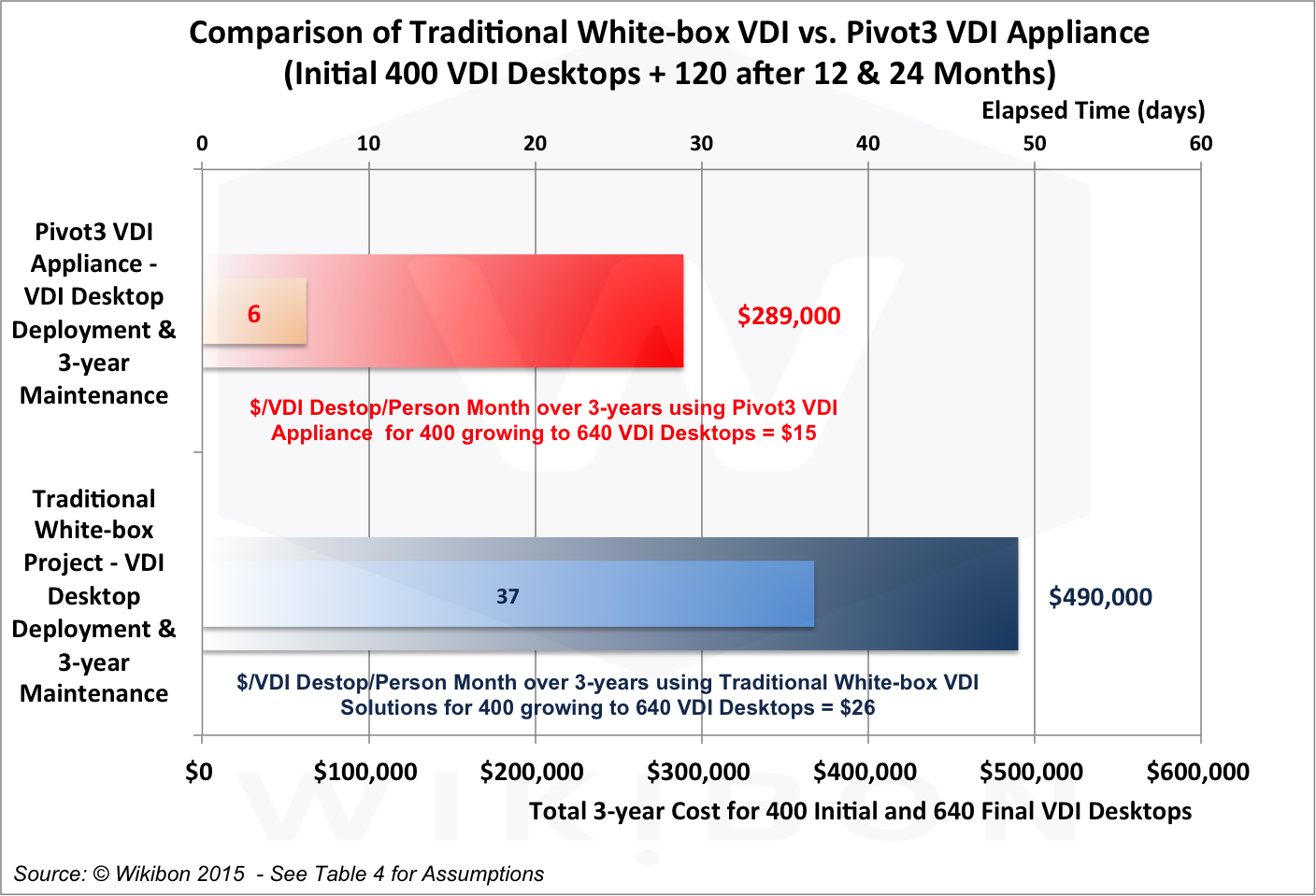
Source: © Wikibon 2015, based on the assumptions and calculations in Table 3 in the Footnotes, itself derived from Tables 5 & 6 in the Footnotes below.
Figure 5 below shows a more detailed breakout of the 640 VDI deployment scenario costs. The three-year hardware cost for the appliance is $42,000 less expensive, and the licensing cost is about $38,000 lower over three years. The biggest difference is in the overall operational costs, which are about $90,000 less. Overall, the appliance saves $201,000 in set up and maintenance over the white box system.
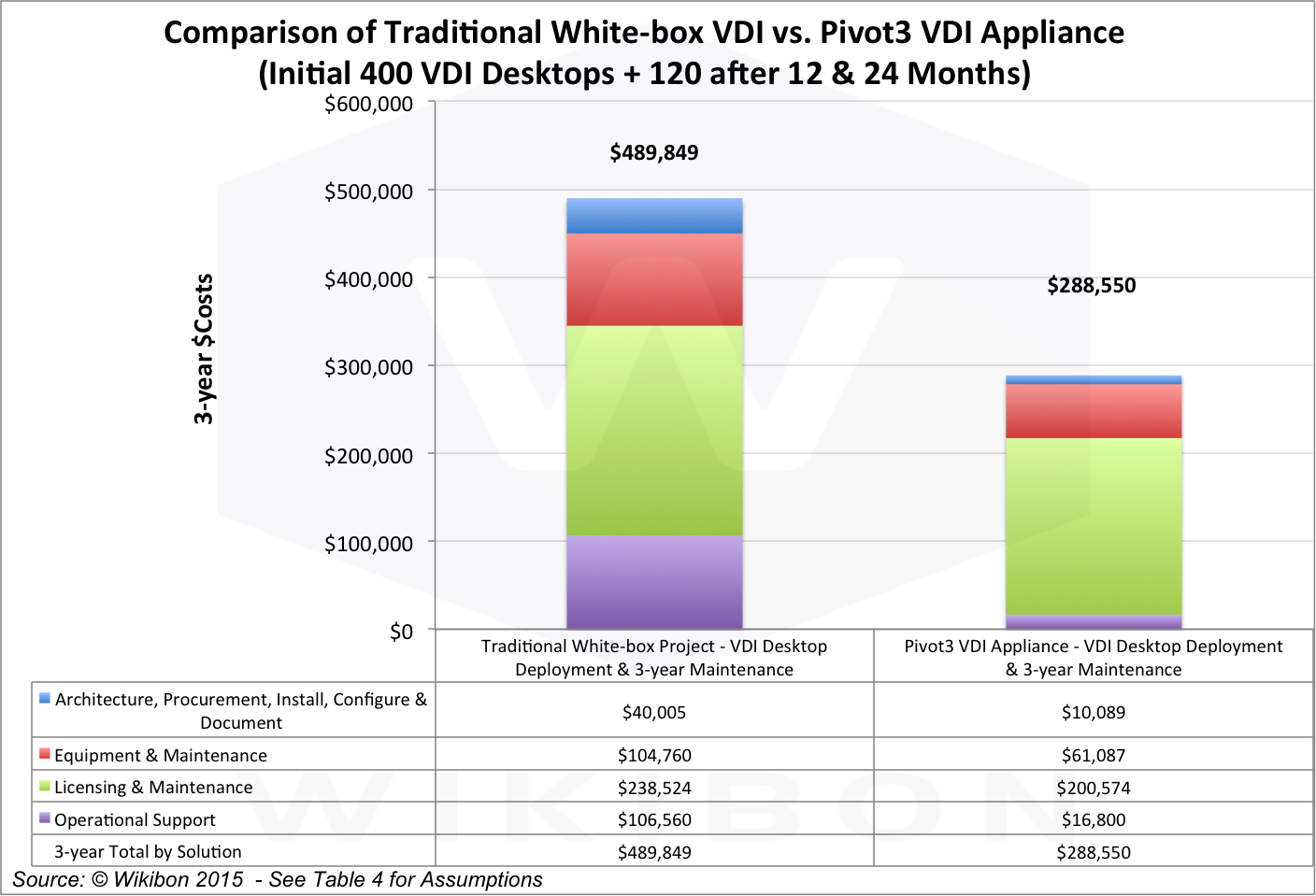
Source: © Wikibon 2015, based on the assumptions and calculations in Table 4 in the Footnotes, itself derived from Tables 5 & 6 in the Footnotes below.
Figure 6 shows that elapsed time for each stage of a project is reduced by a factor of about six, from 37 days to six days.
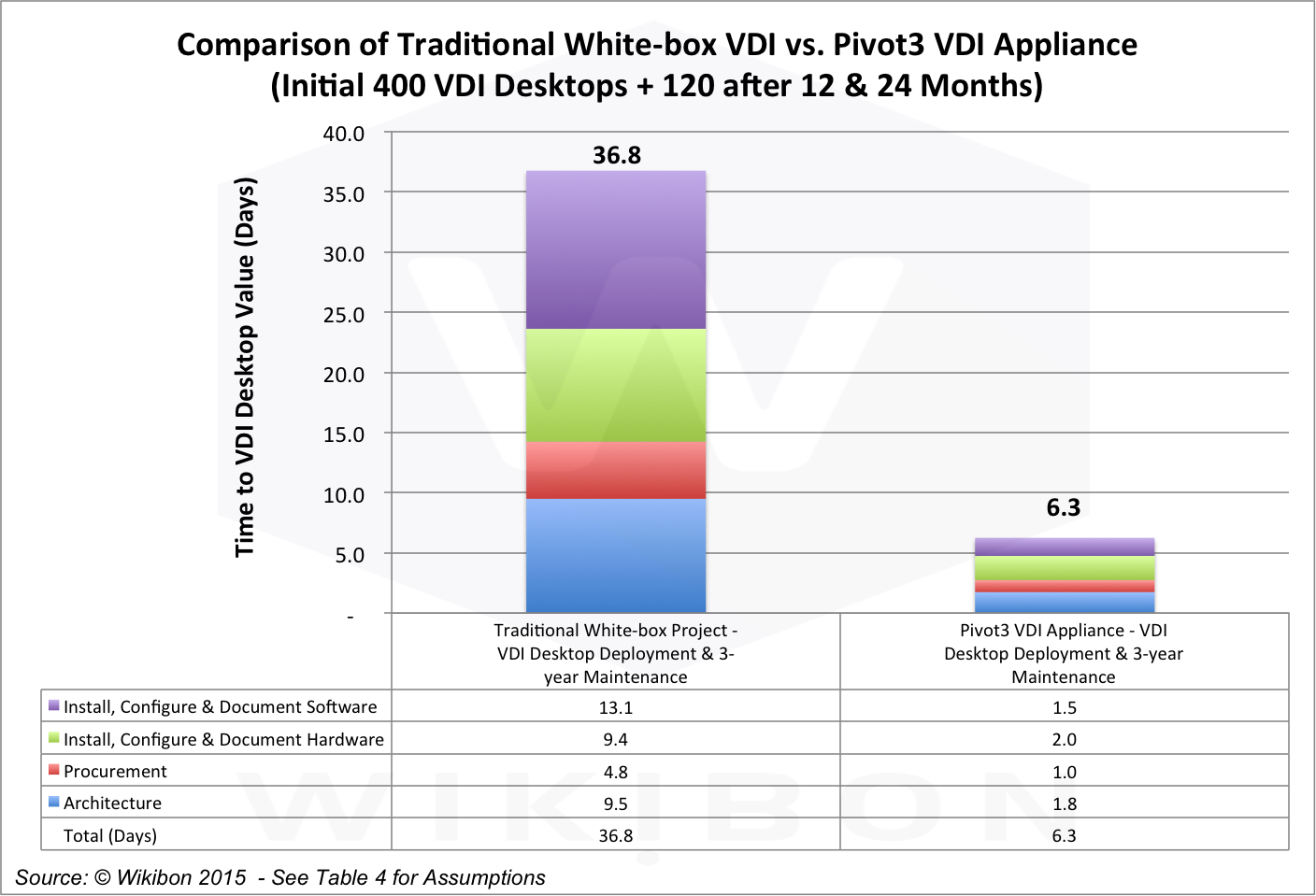
Conclusions & Recommendations
One of the consistent business drivers for converged infrastructure is the business (and IT) imperative to be cost competitive with cloud services. A good overall cost metric is the cost per person-month for a VDI desktop. This is shown in Table 1 below in the “$/VDI Desktop/Person Month over three years” line item. For the 640 Desktop scenario, the cost of using the Pivot3 VDI appliance is $15 per person-month over three years, compared with $26 for the traditional white-box approach. Using a white-box approach is 70% more expensive than using the Pivot3 converged application appliance for VDI. Earlier research comparing a converged on-site approach to cloud approaches can be found at “Duplicating Public Cloud Economics for Microsoft Unified Communications”, and shows the $15/month/user cost for a desktop as very competitive with cloud services, which are about $20/month/user.
The business case for using the converged application appliance model is also very sound. Because the initial costs are lower for the Pivot3 environment (no investment required). Table 1 shows the rate of return as infinite for the 640 desktop scenario, with a break-even at 0 months. Table 1 also shows the CAPEX and OPEX payments are lower. The net present value of the project, taking into account the time value of money (5%/year), is $188,000.
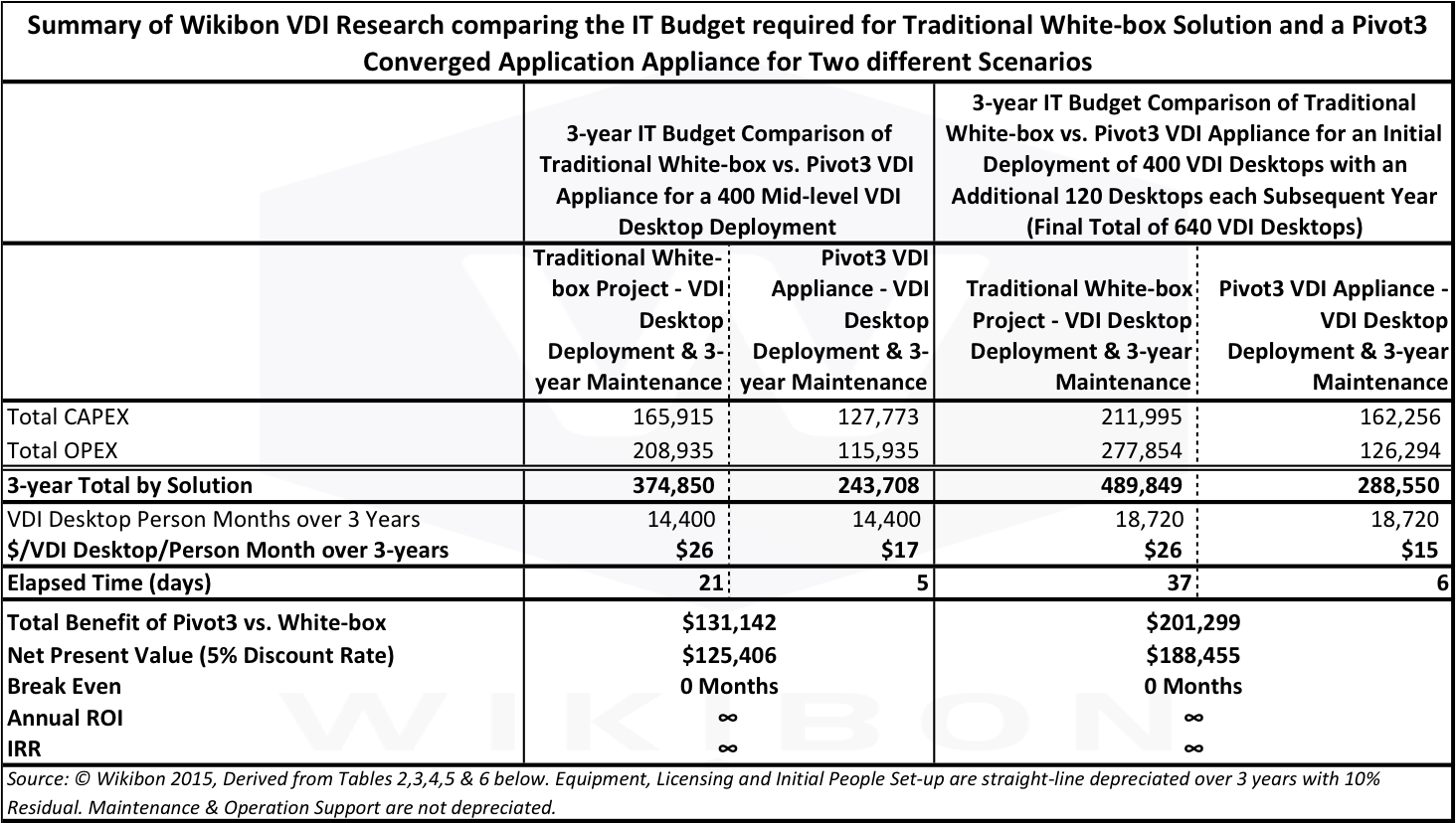
Source: © Wikibon 2015, Derived from Tables 3,4,5 & 6 in the Footnotes below.
The detail of the business case of 640 desktops is shown in Table 2 below, and is the source of the business metrics in Table 1.
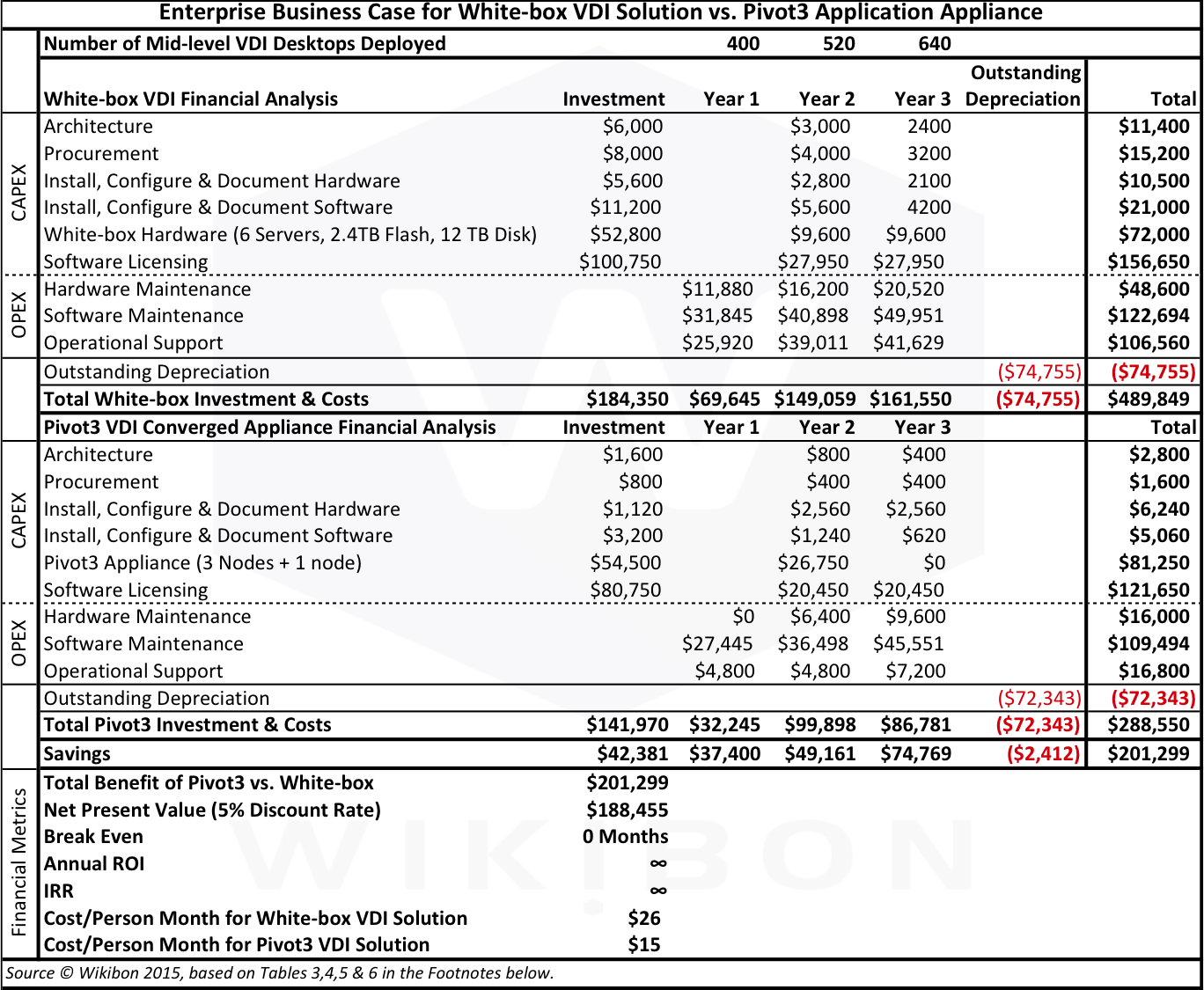
Source: © Wikibon 2014, Derived from Tables 4,5 & 6 in the Footnotes below.
The overall conclusion of this research is the Pivot3 converged application appliance for VDI is a superior and more flexible approach that the traditional best-of-breed white-box approach, and the resulting cost of $15/desktop/month is very competitive with cloud service offerings in the range of $20/desktop/month. The local converged solution has great potential for much better and more consistent response times for the users.
Action Item:
Wikibon research demonstrates that converged application appliances, offer significantly lower costs and faster time-to-value for VDI applications than traditional white-box solutions. Pivot3 have introduced a specific converged application appliance for VDI desktops, providing a single source, a single sets of updates, a single hand to shake, and a single throat to choke. Wikibon recommends the Pivot3 converged VDI application appliance be included in any RFP for VDI implementation.
Footnotes
Note: Table 3 & 4 represent an IT budget point of view, with depreciation taken out. This is the most accurate method for making business comparisons and decisions. The $/user/month are lower because depreciation is taken into account. The inputs into Tables 3 and 4 are tables 5 and 6.
Table 5 & 6 represent a pure cash flow point of view, assuming there is no value in equipment at the end of three years. These tables provide the input for Tables 3 and 4.
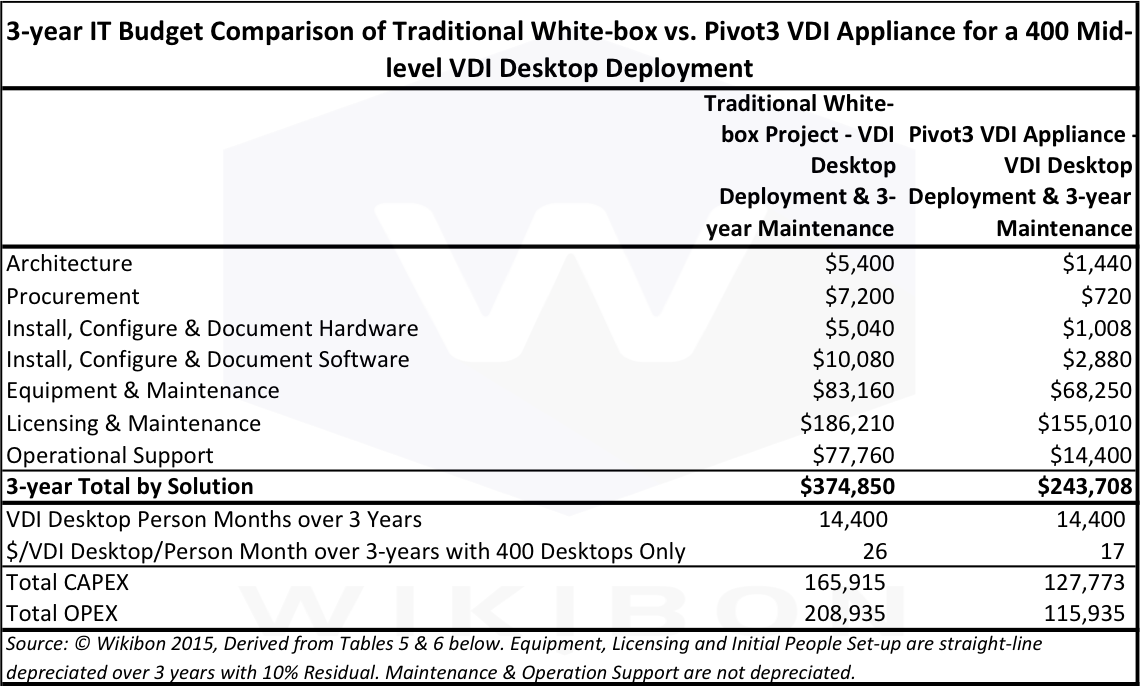
Source: © Wikibon 2015, Derived from Tables 5 & 6 below.
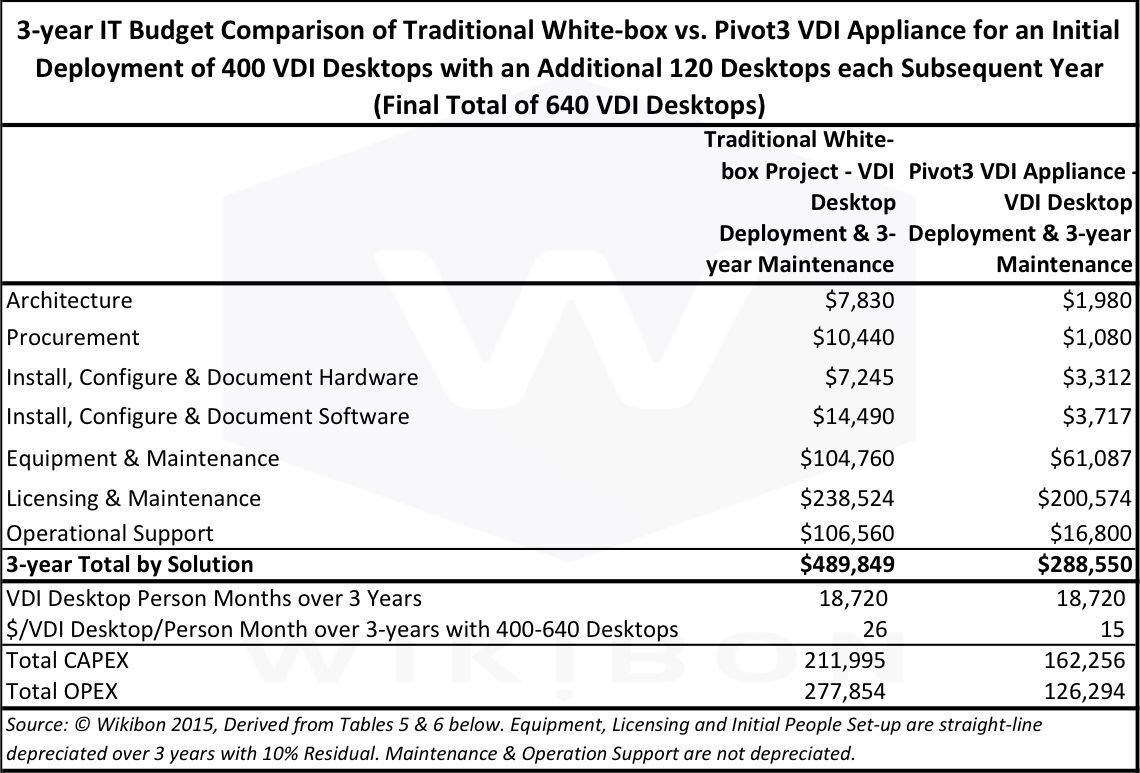
Source: © Wikibon 2015, Derived from Tables 5 & 6 below.
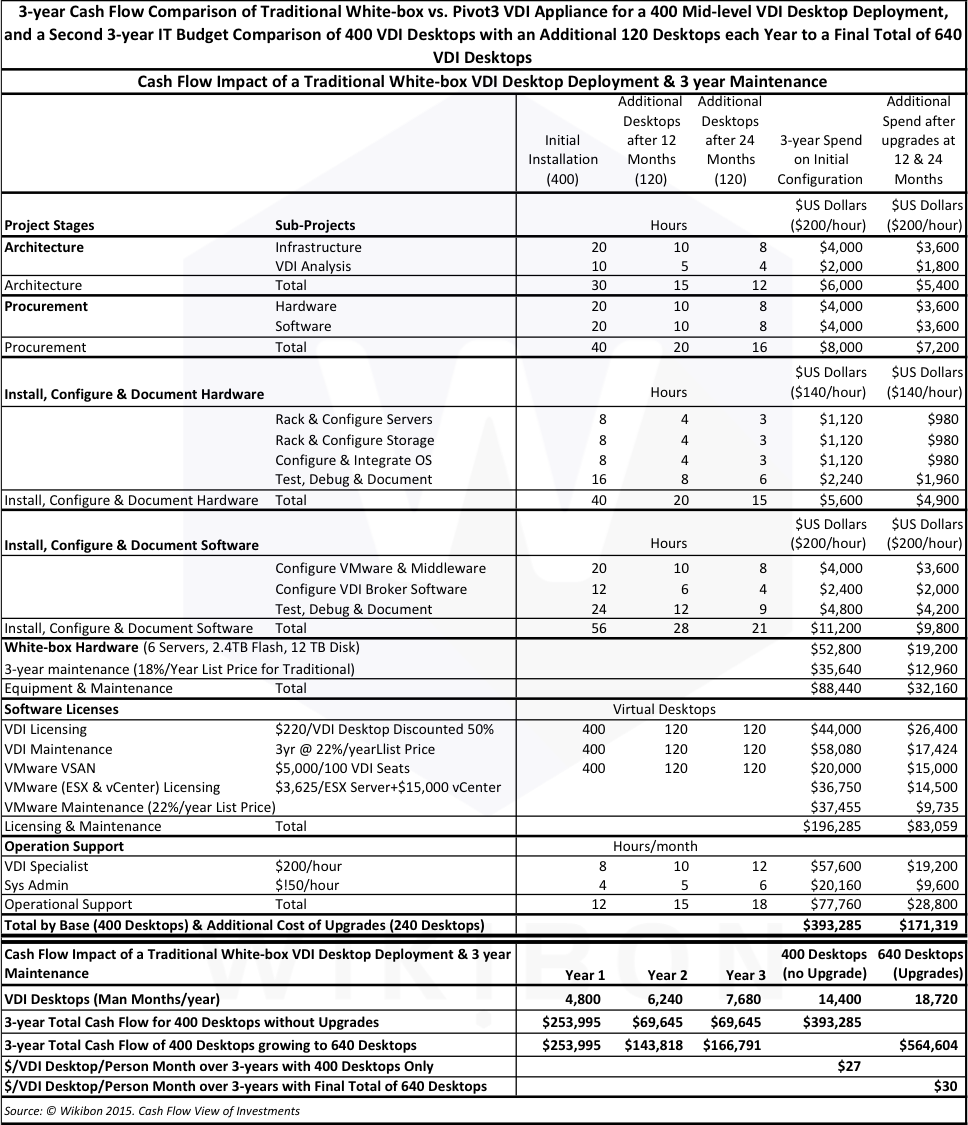
Source: © Wikibon 2015.
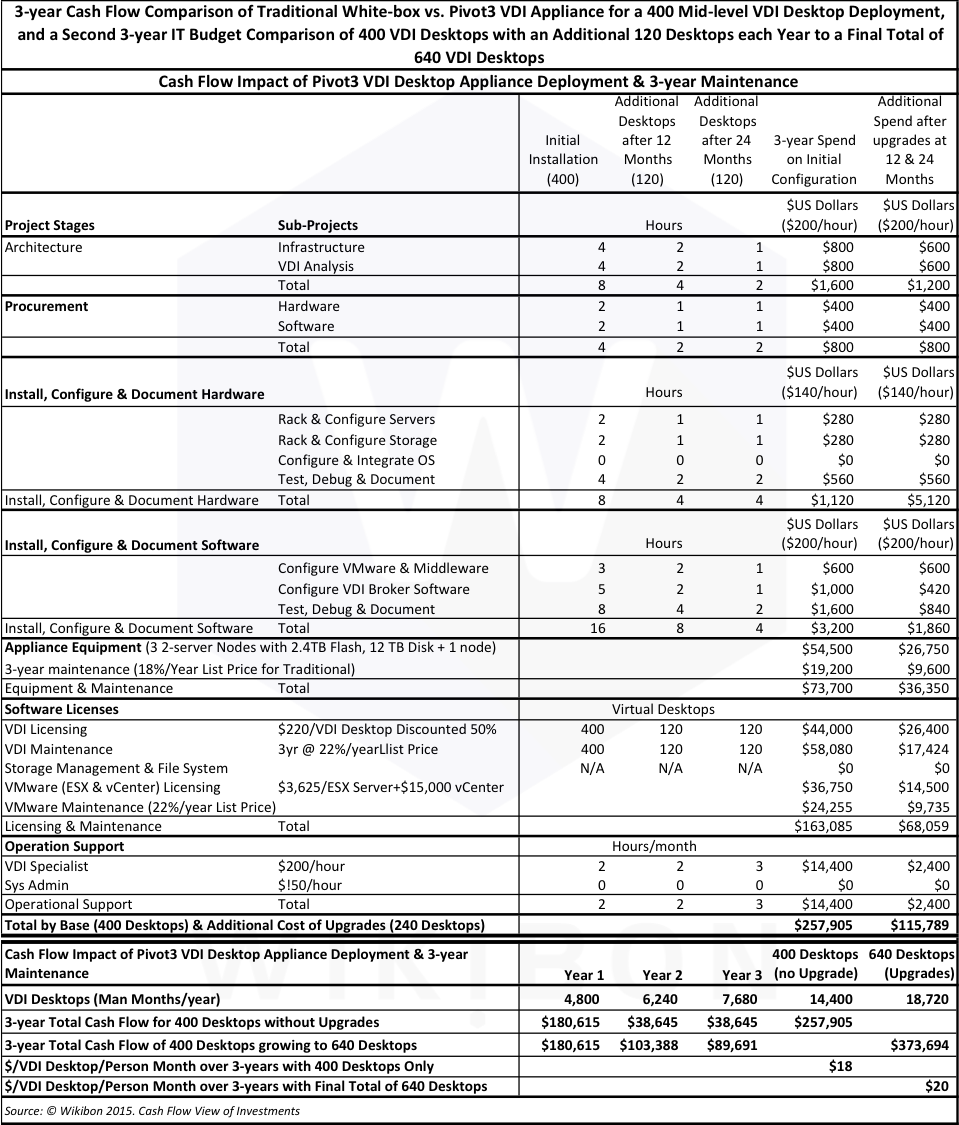
Source: © Wikibon 2015. Note: Appliance Equipment and Maintenance costs are derived from Table 7 below.
Table 7 below is the Pivot3 appliance costs. The Appliance Equipment line in Table 6 is treated as capital, and is the sum of the Table 7 Hardware, Software and Service lines in the Discount 400 and +240 seat columns. The support line in Table 7 is the origin for the Appliance Equipment Maintenance line in Table 6.
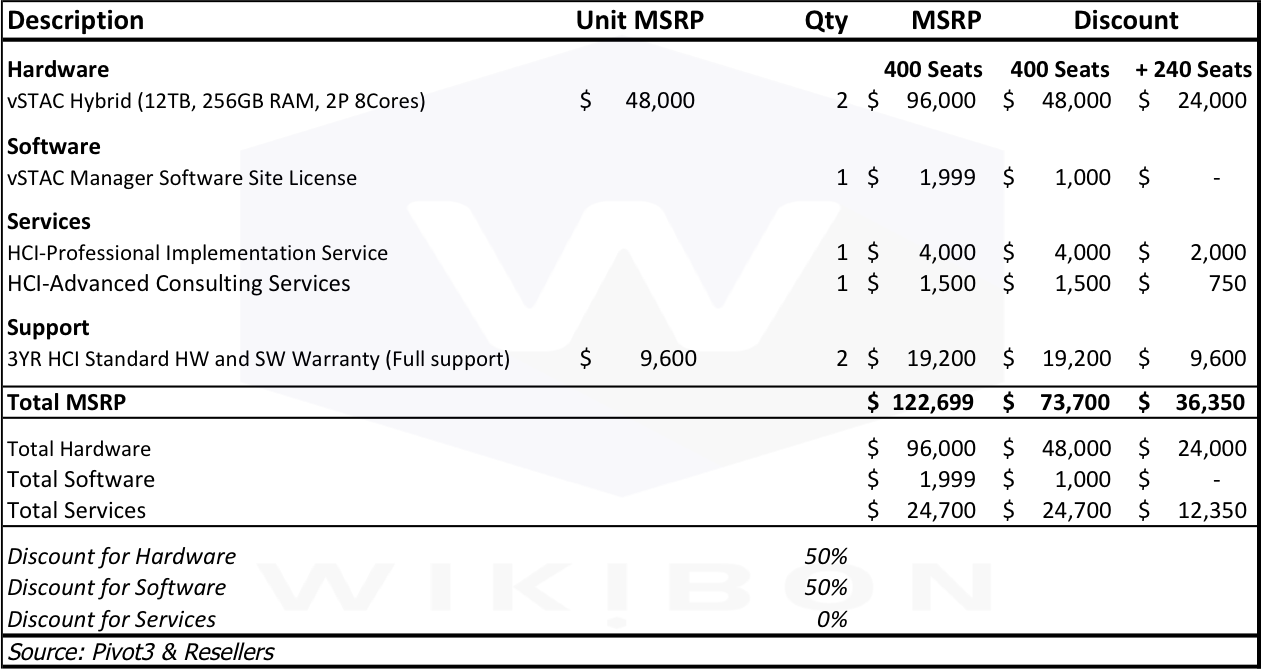
Source: Pivot3 & Resellers


